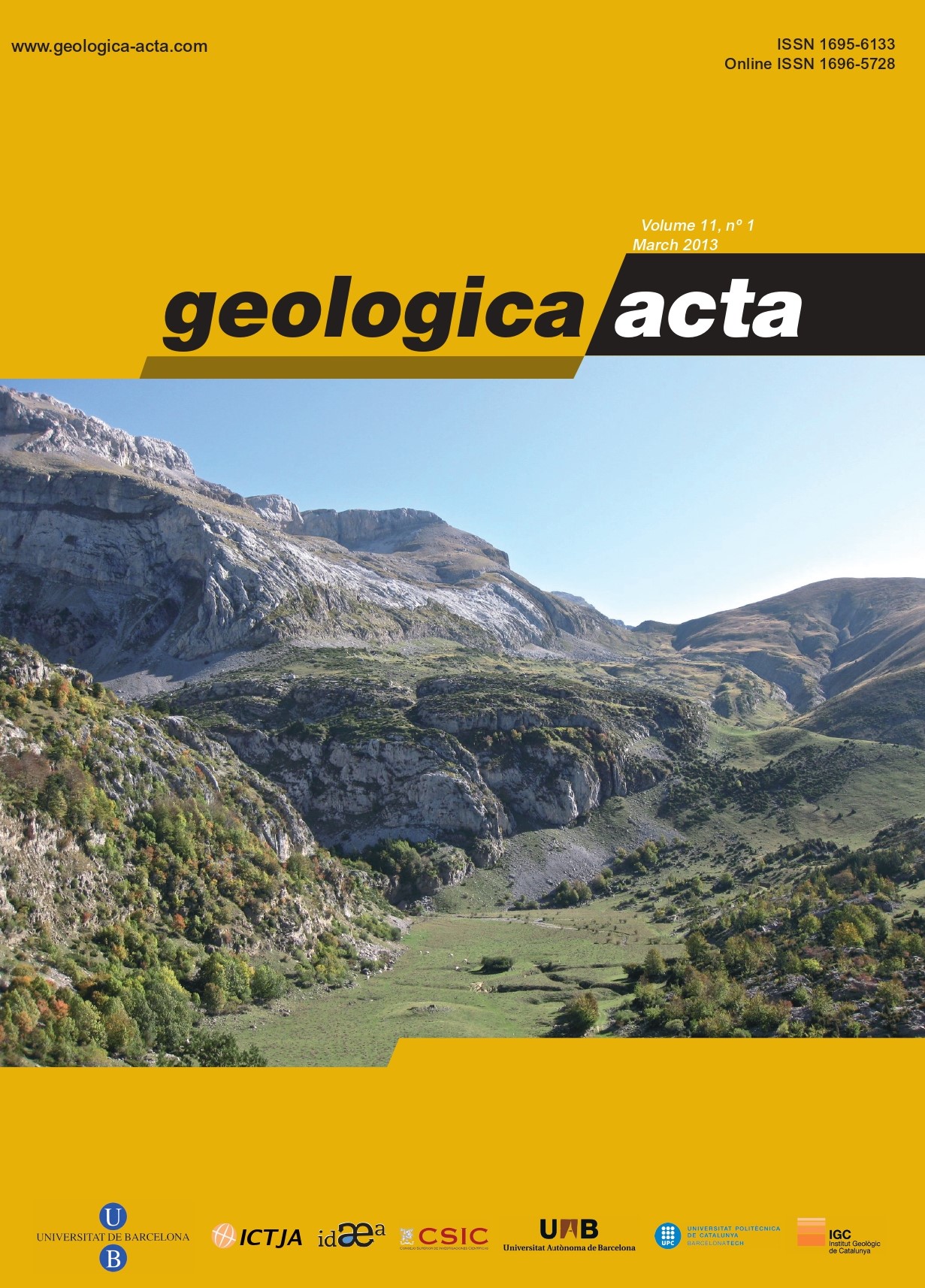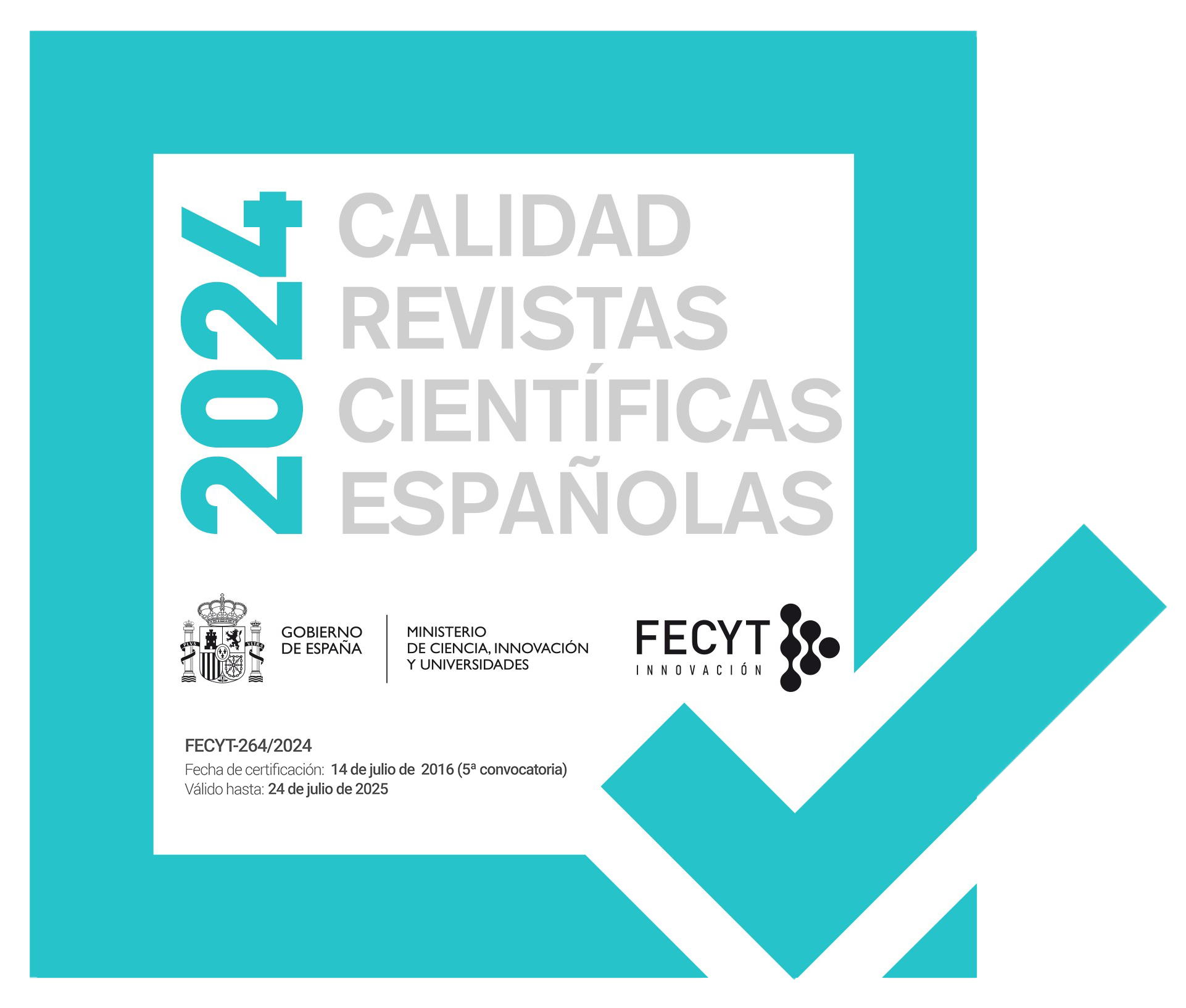Tufa sedimentation in changing hydrological conditions: the River Mesa (Spain)
DOI:
https://doi.org/10.1344/105.000001774Keywords:
Recent fluvial tufas, Deposition rates, Hydrochemistry, Hydrological variability, Continental Mediterranean climateAbstract
The processes controlling tufa deposition along the River Mesa (NE Spain) were studied from April 2003 to September 2009, based on six-monthly monitoring of physical and chemical parameters of the river water and sedimentological characteristics, including deposition rates on tablets. With a mean annual discharge around 1.5m3/s, the sedimentation rate (mean 2mm/yr) recorded important spatial, seasonal and interannual variations. The river waters are of the calcium bicarbonate type. In this study, three distinct river stretches were distinguished based on the steady groundwater inputs, some of low-thermal nature. Groundwater discharges controlled the water chemical composition, and some sedimentation features too. At each stretch, an increase in pCO2 and conductivity was measured around the spring sites. Decreasing trends in conductivity or alkalinity with high enough saturation values with respect to calcite were only clearly observed in the intermediate stretch, which had higher tufa deposition rates than the other two. Tufa deposition rates were higher in cool (autumn+winter) than in warm (spring+summer) periods. In some low-rainfall warm periods, tufa deposition was inhibited or limited due to the low flow –mainly from groundwater inputs– and to the dryness of some river sites, which indeed favoured erosion during flooding. A decrease in yearly deposition rates from April 2006 onwards paralleled an important reduction in the river discharge. Groundwater inputs, drought periods and flood events should therefore be considered to understand fluvial tufa sedimentation in semi-arid conditions.
References
Arenas, C., Osácar, C., Sancho, C., Vázquez-Urbez, M., Auqué, L., Pardo, G., 2010. Seasonal record from recent fluvial tufa deposits (Monasterio de Piedra, NE Spain): sedimentological and stable isotope data. In: Pedley, M., Rogerson, M. (eds.). Tufas and Speleothems: Unravelling the Microbial and Physical Controls. London, Geological Society, 336 (Special Publications), 119-142.
Arp, G., Wedemeyer, N., Reitner, J., 2001. Fluvial Tufa Formation in a Hard-Water Creek (Deinschwanger Bach, Franconian Alb, Germany). Facies, 44, 1-22.
Auqué, L.F., Acero, P., Gimeno, M.J., Gómez, J.B., Asta, M.P., 2009. Hydrogeochemical modeling of a thermal system and lessons learned for CO2 geologic storage. Chemical Geology, 268, 324-336.
Ball, J.W., Nordstrom, D.K., 2001. User’s manual for WATEQ4F, with revised thermodynamic data base and test cases for calculating speciation of major, trace, and redox elements in natural waters. US Geological Survey, Open File Report, 91-183.
Chafetz, H.S., Utech, N.M., Fitzmaurice, S.P., 1991. Differences in the δ18O and δ13C signatures of seasonal laminae comprising travertine stromatolites. Journal of Sedimentary Petrology, 61, 1015-1028.
Chen, J., Zhang, D.D., Wang, S., Xiao, T., Huang, R., 2004. Factors controlling tufa deposition in natural waters at waterfall sites. Sedimentary Geology, 166, 353-366.
Drysdale, R., Gillieson, D., 1997. Micro-erosion meter measurements of travertine deposition rates: a case study from Louie Creek, northwest Queensland, Australia. Earth Surface Processes and Landforms, 22, 1037-1051.
Drysdale, R.N., Taylor, M.P., Ihlenfeld, C., 2002. Factors controlling the chemical evolution of travertine-depositing rivers of the Barkly karst, northern Australia. Hydrological Processes, 16, 2941-2962.
Emeis, K.C., Richnow, H.H., Kempe, S., 1987. Travertine formation in Plitvice National Park, Yugoslavia: chemical versus biological control. Sedimentology, 34, 595-609.
Ford, T.D., Pedley, H.M., 1996. A review of tufa and travertine deposits of the world. Earth Science Reviews, 41, 117-175.
Lunar, R., Moreno, T., Lombardero, M., Regueiro, M., LópezVera, F., Martínez del Olmo, W., Mallo García, J.M., Sáenz de Santa María, J.A., García-Palomero, F., Higueras, P., Ortega, L., Capote, R., 2002. Economic and environmental geology. In: Gibbons, W., Moreno, T. (eds.). The Geology of Spain. London, Geological Society, 473-510.
Herman, J.S., Lorah, M.M., 1988. Calcite precipitation rates in the field: Measurement and prediction for a travertine-depositing stream. Geochimica et Cosmoschimica Acta, 52, 2347-2355.
Hori, M., Koshino, K., Okumura, K., Kano, A., 2008. Seasonal patterns of carbon chemistry and isotopes in tufa depositing groundwaters of southwestern Japan. Geochimica et Cosmoschimica Acta, 72, 480-492.
Hori, A., Kawai, T., Matsuoka, J., Kano, A., 2009. Intra-annual perturbations of stable isotopes in tufas: Effects of hydrological processes. Geochimica et Cosmoschimica Acta, 73, 1684-1695.
Jacobson, R.L., Usdowski, E., 1975. Geochemical controls on a calcite precipitating spring. Contributions to Mineralogy and
Petrology, 51, 65-74.
Kano, A., Matsuoka, J., Kojo, T., Fujii, H., 2003. Origin of annual laminations in tufa deposits, southwest Japan. Palaeogeography, Palaeoclimatology, Palaeoecology, 191, 243-262.
Kawai, T., Kano, A., Matsuoka, J., Ihara, T., 2006. Seasonal variation in water chemistry and depositional processes in a tufa-bearing stream in SW-Japan, based on 5 years of monthly observations. Chemical Geology, 232, 33-53.
Kawai, T., Kano, A., Hori, A., 2009. Geochemical and hydrological controls on biannual lamination of tufa deposits. Sedimentary Geology, 213, 41-50.
Liu, Z., Svensson, U., Dreybrodt, W., Daoxian, Y., Buhmann, D., 1995. Hydrodynamic control of inorganic calcite precipitation
in Huanglong Ravine, China: Field measurement and theoretical prediction of deposition rates. Geochimica et Cosmoschimica Acta, 59, 3087-3097.
Lojen, S., Dolenec, T., Vokal, B., Cukrov, N., Mihelčić, G., Papesch, W., 2004. C and O stable isotope variability in recent freshwater carbonates (River Krka, Croatia). Sedimentology, 51, 361-375.
Lorah, M.M., Herman, J.S., 1988. The chemical evolution of a travertine-depositing stream: geochemical processes and mass transfer reactions. Water Resources Research, 24, 1541-1552.
Lu, G., Zheng, C., Donahoe, R.J., Lyons, B., 2000. Controlling processes in a CaCO3 precipitating stream in Huanglong Natural Scenic District, Sichuan, China. Journal of Hydrology, 230, 34-54.
Matsuoka, J., Kano, A., Oba, T., Watanabe, T., Sakai, S., Seto, K., 2001. Seasonal variation of stable isotopic compositions recorded in a laminated tufa, SW Japan. Earth and Planetary Science Letters, 192, 31-44.
Merz-Preib, M., Riding, R., 1999. Cyanobacterial tufa calcification in two freshwater streams: ambient environment, chemical thresholds and biological processes. Sedimentary Geology, 126, 103-124.
Nemeth, K., 1963. Photometric determination of sulphate in soil extracts. Zeitschrift für Pflanzenernährung, Düngung, Bodenkunde, 103, 193-196.
Ordóñez, S., González Martín, J.A., García del Cura, M.A., Pedley, H.M., 2005. Temperate and semi-arid tufas in the Pleistocene to Recent fluvial barrage system in the Mediterranean area: the Ruidera Lakes Natural Park (central Spain). Geomorphology, 69, 332-350.
Parkhurst, D.L., Appelo, C.A.J., 1999. User’s Guide to PHREEQC (Version 2), a computer program for speciation, batch-reaction, one-dimensional transport, and inverse geochemical calculations. Water Resources Research Investigations, 99-4259(Report), 312pp.
Pedley, H.M., 2009. Tufas and travertines of the Mediterranean region: a testing ground for freshwater carbonate concepts
and developments. Sedimentology, 56, 221-246. doi:10.1111/j.1365-3091.2008.01012.x
Pentecost, A., 1996. Moss growth and travertine deposition: the significance of photosynthesis, evaporation and degassing of carbon dioxide. Journal of Bryology, 19, 229-234.
Pinuaga-Espejel, J.I., Garrido, E., Ramírez, A., 2004. Geología, hidrogeología y protección de los balnearios de Jaraba (Zaragoza). Anales de la Real Academia Nacional de Farmacia, 70, 587-610.
Servicio Geológico de Obras Públicas, 1990. Estudio de los recursos hidráulicos subterráneos de los acuíferos relacionados con la provincia de Zaragoza. Madrid, Sierra del Solorio, Unidad hidrogeológica, 43 (Internal report), 210pp.
Shiraishi, F., Reimer, A., Bisset, A., de Beer, D., Arp, G., 2008. Microbial effects on biofilm calcification, ambient water chemistry and stable isotope records in a highly supersaturated setting (Westerhöfer Bach, Germany). Palaeogeography,
Palaeoclimatology, Palaeoecology, 262, 91-106.
Tena, J.M., Auqué, L.F., Gimeno, M.J., Mandado, J., 1995. Evolución fisicoquímica y geotermometría del sistema hidrotermal de Alhama–Jaraba (Provincia de Zaragoza). Zaragoza, Institución Fernando el Católico, 178pp.
Vázquez-Urbez, M., 2008. Caracterización y significado ambiental de depósitos tobáceos neógenos de la Cuenca del Ebro. Comparación con ambientes Cuaternarios. Doctoral Thesis. Zaragoza, University of Zaragoza, 476pp. Last web page check February, 2012: http://zaguan.unizar.es/record/2057/files/TESIS-2009-038.pdf
Vázquez-Urbez, M., Arenas, C., Sancho, C., Osácar, M.C., Auqué, L., Pardo, G., 2010. Factors controlling present-day tufa dynamics in the Monasterio de Piedra Natural Park (Iberian Range, Spain): depositional environmental settings, sedimentation rates and hydrochemistry. International Journal of Earth Sciences, 99, 1027-1049.
Vázquez-Urbez, M., Arenas, C., Sancho, C., Auqué, L., Osácar, C., Pardo, G., 2011. Quaternary and present-day tufa systems of the Piedra and Añamaza rivers (Iberian Range, Spain). In: Arenas, C., Pomar, L., Colombo, F. (eds.). Geo-Guías, 8. Zaragoza, Sociedad Geológica de España, 241-274.
Vázquez-Urbez, M., Arenas, C., Pardo, G., 2012. A sedimentary facies model for stepped, fluvial tufa systems in the Iberian Range (Spain): the Quaternary Piedra and Mesa valleys. Sedimentology, 59, 502-526. doi: 10.1111/j.1365-3091.2011.01262.x
Vera, J.A., 2004. Geología de España. Sociedad Geológica de España - Instituto Geológico y Minero de España, Madrid, 890pp.
Yoshimura, K., Liu, Z., Cao, J., Yuan, D., Inokura, Y., Noto, M., 2004. Deep source CO2 in natural waters and its role in extensive tufa deposition in the Huanglong Ravines, Sichuan, China. Chemical Geology, 205, 141-153.
Downloads
Published
Issue
Section
License

This work is licensed under a Creative Commons Attribution-ShareAlike 4.0 International License.
Copyright
Geologica Acta is the property of the UB, GEO3BCN, IDAEA and UAB. Geologica Acta must be cited for any partial or full reproduction. Papers are distributed under the Attribution-Share Alike Creative Commons License. This license allows anyone to reproduce and disseminate the content of the journal and even make derivative works crediting authorship and provenance and distributing possible derivative works under the same or an equivalent license.
Author Rights
Authors retain the copyright on their papers and are authorized to post them on their own web pages or institutional repositories. The copyright was retained by the journal from the year 2003 until 2009. In all cases, the complete citation and a link to the Digital Object Identifier (DOI) of the article must be included.
The authors can use excerpts or reproduce illustrations of their papers in other works without prior permission from Geologica Acta provided the source of the paper including the complete citation is fully acknowledged.




